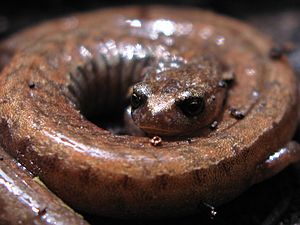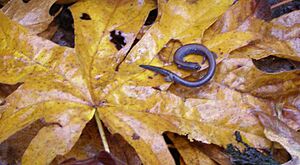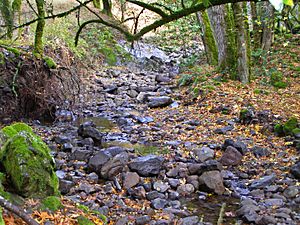California slender salamander facts for kids
Quick facts for kids California slender salamander |
|
|---|---|
 |
|
| Conservation status | |
| Scientific classification |
The California slender salamander (Batrachoseps attenuatus) is a special kind of salamander that doesn't have lungs! It lives mostly in the coastal mountains of Northern California, United States, and a small part of southwestern Oregon. This small amphibian is unique because it's one of the few animals found almost only in California.
Scientists once thought there was only one type of California slender salamander. But in 2001, a professor named David Wake and his students found out that what they thought was one species was actually about twenty different species! Each of these salamanders has four toes on each foot. The name attenuatus comes from a Latin word meaning slender, which perfectly describes them.
Contents
What Does the California Slender Salamander Look Like?
This type of lungless salamander is usually about 7 to 13 centimeters long. Like all slender salamanders, its body and head are narrow. It breathes through its skin, not with lungs. This salamander has four toes on each foot, just like all other salamanders in its group.
It has 18 to 21 clear grooves on its sides, which make it look a bit like a worm. Usually, its back is black with a reddish or brown stripe. Its belly is dark with tiny white dots. The California slender salamander has very thin, moist skin.
Most animals with backbones, like mammals, have red blood cells without a nucleus when they are grown up. But the California slender salamander is one of the few exceptions. Its red blood cells still have a nucleus, even when they are mature!
Where Do California Slender Salamanders Live?
These salamanders mostly live in the coastal mountains of Northern California. You can find them from Monterey County up to Humboldt County. In this area, they can be found up to about 75 miles from the Pacific Ocean. This includes coastal areas and inner mountain ranges, as well as valley floors.
North of Mendocino County, they live in a narrower strip along the coast, about 10 to 40 miles from the ocean. You can also find them on the western slopes of the Sierra Nevada foothills, as far north as Butte County. In a few smaller spots, they also live in parts of the northern California Central Valley.
In the early 1990s, these salamanders were often found under rocks in the Sunol Regional Wilderness park. They have even been found in water tanks on Alcatraz Island!
What Kind of Homes Do They Like?
The California slender salamander lives in many different types of places. These include California oak woodlands, redwood forests, Douglas fir forests, and even grasslands. They can be found from valley floors up to mid-level elevations in coastal mountains.
From about October to March, these salamanders look for cover near streams and other wet places. You can often find them hiding under fallen leaves, rotting logs, or rocks where it's moist. Their slender shape helps them squeeze into earthworm or termite burrows. They do this to hunt for tiny creatures like mites, spiders, and snails.
When the dry season starts in April, they go into tunnels or burrows, even rodent homes. This helps them find a cooler, wetter place to hide than the surface.
California slender salamanders can even live in some cities and suburbs. For example, people have found them in their yards and patios in the San Francisco Bay Area.
How Do They Behave and Reproduce?
From fall to spring, the California slender salamander is active on the ground. They search for food under leaf litter and in tunnels made by other animals. They are especially active when it rains lightly and right after. From May to October, they go into a resting state called aestivation to avoid the dry heat.
Unlike other salamanders in their group, they lay eggs quite early, sometimes as early as December in the southern parts of their range. They usually lay their eggs in tunnels made by other creatures. But egg clusters have also been found on wet surfaces under bark, rocks, or other forest debris.
Each group of eggs usually has about five to twenty eggs. Sometimes, five to ten different female salamanders might use the same spot to lay their eggs. The eggs usually hatch around March or April, or a bit later in the far northern areas.
Many animals hunt the California slender salamander. These include larger arthropods and birds that are active during the day, especially those that look for food among leaves. Snakes, like the ringneck snake, are also big predators of Batrachoseps attenuatus.
When it comes to finding food, the California slender salamander is very good at searching in narrow tunnels. This helps it find food that other salamander species might miss.
Protecting the California Slender Salamander
In California
The state of California does not have specific laws to protect the California slender salamander. However, several groups have suggested it should be protected. For example, in 1992, the University of California Department of Agriculture and Natural Resources published a booklet. It explained how native oak trees and animals like the California slender salamander depend on each other.
In 1999, a group of artists called BayWood Artists tried to help save the salamander's home. They held an art show and sale to raise money for the Oakwood Valley Restoration Project. This project aimed to protect the salamander's habitat in the Golden Gate National Recreation Area.
In Oregon
The state of Oregon takes protecting the California slender salamander seriously. In 2002, the Oregon Department of Fish and Wildlife made a rule. It became illegal to hunt, trap, kill, or even have a California slender salamander, whether dead or alive.
In 2003, a group called the Natural Heritage Advisory Council said that the California slender salamanders living in Winchuck Slope were part of Oregon's natural heritage. They believed these salamanders needed to be protected.
See also
 In Spanish: Batrachoseps attenuatus para niños
In Spanish: Batrachoseps attenuatus para niños





